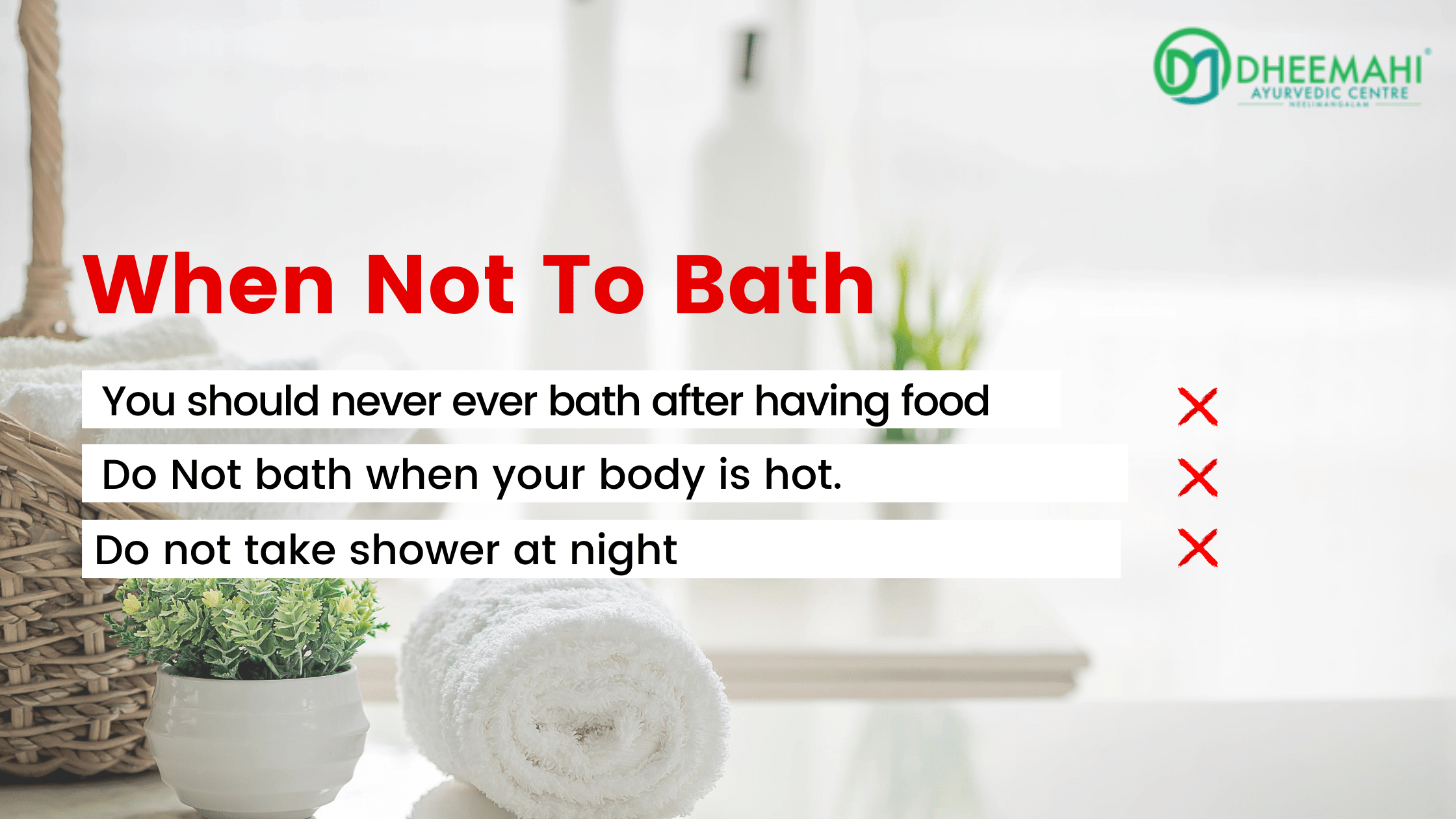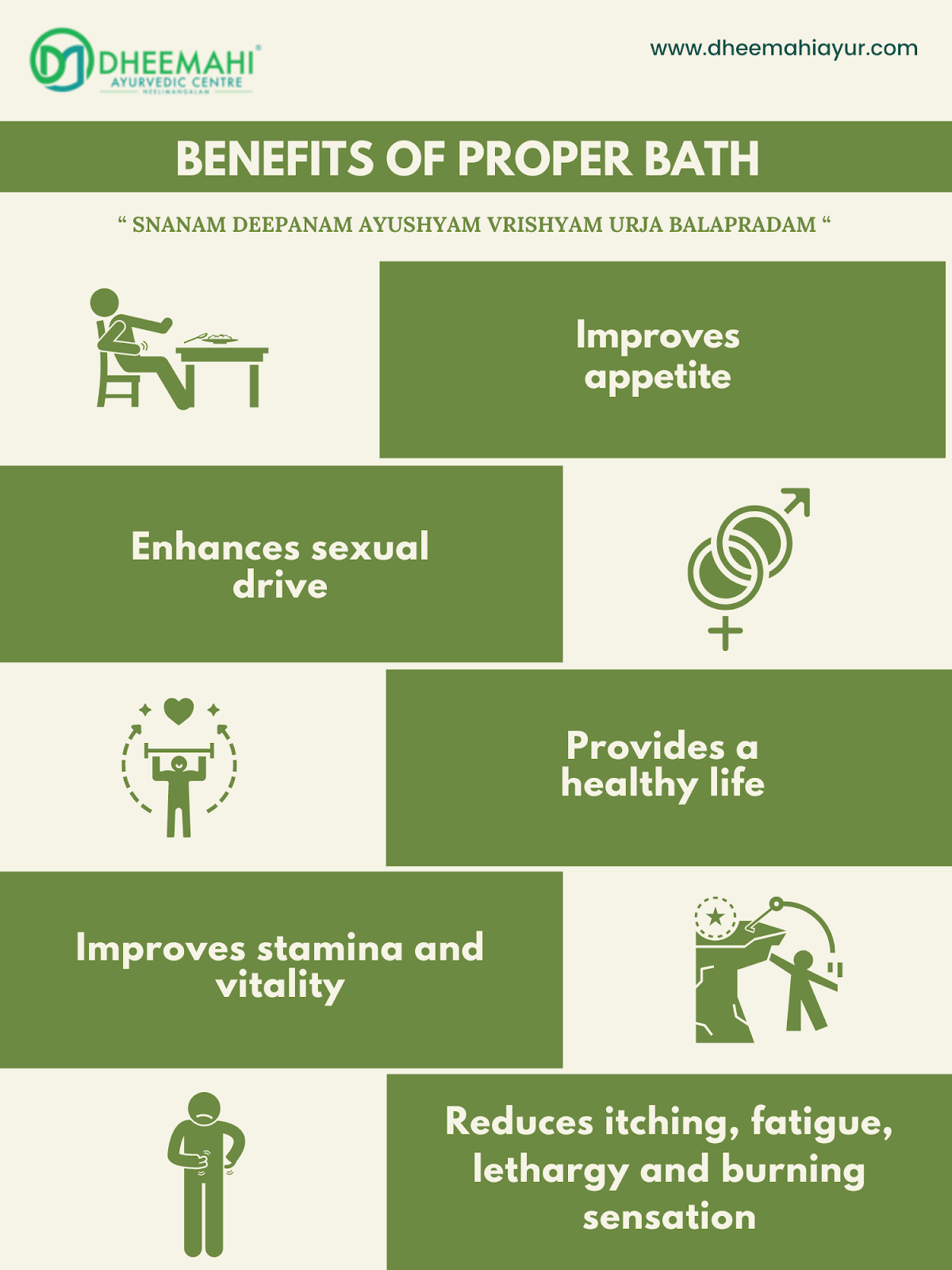Shower Mistakes, You May Have Been Doing It Wrong
— Dr. Namitha Suseel B.A.M.S
Skin is the largest organ in the human body. An adult carries approximately 3.6kg and 2 square metres of skin. Human skin consists of three layers: the epidermis, the dermis and the subcutaneous tissue. The epidermis is the outer layer. It undergoes constant renewal. In every 28 days, all cells are turned over as the most superficial cells are replaced by new ones. This turnover is much faster for infants and slows down over the course of our lifetime. Hence it is important to bath daily to remove the dead cells, sweat and dirt from your body. Bath is given utmost importance in Ayurveda.
Benefits Of Proper Bath:
“Snanam deepanam ayushyam vrishyam urja balapradam”
- Improves appetite
- Enhances sexual drive
- Provides a healthy life
- Improves stamina and vitality.
- Removes sweat and dirt from the body
- Reduces itching, fatigue, lethargy and burning sensation.
A daily bathing habit early in the morning before taking food is the best. The bath should always be taken before food as it is a good appetiser. If you are a healthy person you might have surely felt hungry after having a good shower. People who don’t eat for a long time after bath have an increased chance of having acidity and gastric problems.
Studies have proven that sudden exposure to cold like taking a cold bath or splashing face with cold water can stimulate the vagus nerve. Vagus nerve supplies sensory impulse and stimulates the involuntary contraction of the digestive tract.

When Not To Take Bath
- You should never ever bath after having food. The body heat or digestive fire which is concentrating on digesting the food you eat gets hampered when you take a shower soon after having food. The blood circulation and body heat concentrate to the periphery thus the food remains undigested. This in future can lead to many grave diseases.
- Do Not bath when your body is hot. Imagine a hot iron rod dipped into the water. We can hear spluttering sound and fumes coming out of it. This same situation happens in your body too. This habit results in inflammation of the fascia covering the muscles known as myofascitis which leads to neck stiffness and pain, low back pain and knee pain. This habit is said to be one of the main causes for many of the eye diseases. So after doing household work or exercise or any activities that increase the body temperature, give time to the body to come back to its normal temperature before you take a shower. Bathing at the noontime or whenever the outside temperature is too hot also has a similar effect.
- Do not take shower at night especially for those having long and thick hair. As a result, the hair doesn’t dry properly and will lead to myofascitis. If you feel very bad without bathing at night, you can wash your body alone. if you wash your head make sure to make it dry before going to sleep.

How To Take Bath
If you are a healthy individual you can bathe in cold water if the climate permits, else wash your head with boiled water cooled to normal room temperature and your body with hot water.
Hot water should never be used to wash your head as it can damage your eyes and hair.
Always wash your head first before washing the body. Bow your head and pour water in the back of your head then wash the rest of the head and later the whole body. This helps in proper stimulation of the vagus nerve.
Who All Should Not Bath
- Persons suffering from the following diseases should not bath daily.
- Facial palsy
- Inflammatory eye diseases
- Diseases of the oral cavity
- Diseases of ear
- Diarrhoea
- Abdominal distension
- Rhinorrhoea – runny nose
- Indigestion
Therapeutic baths have been made use in treating various diseases especially related to skin. Balneotherapy is the medical term for the use of baths to treat disease.
Therapeutic Baths Trending At Present
Contrast bath therapy
Contrast bath therapy is a form of treatment wherein a limb or the entire body is immersed in hot (but not boiling) water followed by the immediate immersion of the limb or body in cold ice water. This procedure is repeated several times, alternating hot and cold.
The theory behind contrast bath therapy is that the hot water causes vasodilation of the blood flow in the limb or body followed by the cold water which causes vasoconstriction and increased local blood circulation. Additionally, the lymph vessels contract when exposed to cold, and relax in response to heat. The lymph system, unlike the circulatory system, lacks a central pump. By alternating hot and cold, it is believed that lymph vessels dilate and contract to “pump” and move stagnant fluid out of the injured area and that this positively affects the inflammation process.
Sudden shifts in body temperature are considered very harmful according to ayurveda. Hence this type of bath is strongly against the principles of ayurveda.
Ice Bath
In this, a substantial part of the human body is immersed in a bath of ice or ice-water for a limited duration. It is done in sports therapy as a training regimen usually following a period of intense exercise
Colloid bath
A medicated bath prepared by adding soothing agents to the bath water such as gelatin, starch, or bran in order to relieve skin irritation and itching.
Oatmeal bath
A Colloid bath containing oatmeal, used for the treatment of dermatoses to soothe the skin and relieve itching
Paraffin bath
The dipping of a limb into a warm solution of paraffin or the brushing of paraffin onto the skin, to provide pain relief and increase mobility.
Having a good bath will ensure proper hygiene, appetite and healthy life. But if done in the wrong way can lead to severe health problems in the long run. To understand and follow the right way of bath and have a healthy and happy life.

